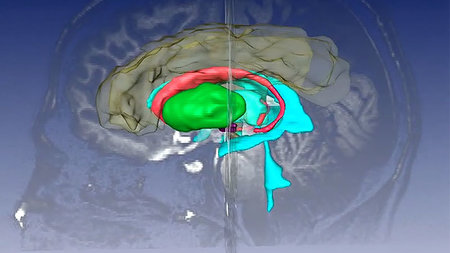Cognitive control of visual perception
Our earlier research has formalized perception by an active, top-down directed inference process in which a target template will be learned and maintained by areas involved in task coordination. This learning of appropriate templates and its activation in time, termed as the cognitive guidance of vision, will be achieved in a reward-based scenario. In this respect, we aim to develop a model of how prefrontal cortex and subcortical structures interact to generate target templates in time and thus guide the vision process. This research project is supported by the DFG.

A) Functional sketch of the model. We propose that solutions for visual perception must flexibly consider prior knowledge. Prior knowledge can either guide vision towards objects of interest or determine the aspects in a visual scene that remain in memory. In both cases a prospective signal (which we also call a target template) is used to enhance the representation of the relevant input. In a visual search situation this top-down signal guides vision through top-down connections which have to be learned. In other cases this signal determines the relevant aspects of a scene which have to be bound towards the present task.
B) Outline of how this model for attention, object recognition and category learning is implemented in the brain. The visual (red) part implements match detection and visual selection. The visual-cognitive (blue) part ensures the learning and activation of the correct template in time. For simplicity, some areas in the ventral pathway are considered at a comparable level and described by a single map (e.g. V1/V2). The connections among the areas are typically bi-directional.
Funding
EU-Project EYESHOTS (Heterogeneous 3-D Perception across Visual Fragments)
German Research Foundation (DFG HA2630/4-1)
Selected Publications
Vitay, J., Hamker, F. H. (2010)
A computational model of the influence of basal ganglia on memory retrieval in rewarded visual memory tasks.
Frontiers in Computational Neuroscience. 4(13).
PDF-document
Vitay, J., Fix, J., Beuth, F., Schroll, H., Hamker, F. H. (2009)
Biological Models of Reinforcement Learning.
Künstliche Intelligenz. 3:12-18.
PDF-document
Vitay, J., Hamker, F. H., (2008)
Sustained activities and retrival in a computational model of perirhinal cortex.
Journal of Cognitive Neuroscience, 20(11): 1993-2005.
PDF-document
Vitay, J., Hamker, F. H. (2007)
On the role of dopamine in cognitive vision.
In: Attention in Cognitive Systems, L. Paletta and E. Rome (eds.), Springer LNAI 4840, 352-366
PDF-document
Hamker, F. H. (2005)
The emergence of attention by population-based inference and its role in distributed processing and cognitive control of vision.
Journal for Computer Vision and Image Understanding. Special Issue on Attention and Performance in Computer Vision, 100:64-106.
PDF-document





